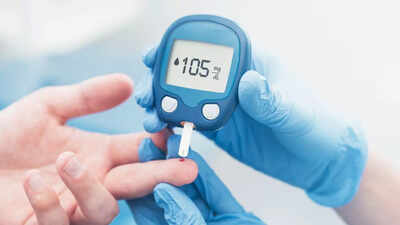For individuals managing diabetes, maintaining stable blood sugar levels is a continuous effort. A common challenge is the occurrence of elevated blood glucose levels upon waking, often referred to as the "Dawn Phenomenon". This article explores the dawn phenomenon, its causes, symptoms, and effective management strategies.

Image: Conceptual illustration of blood sugar monitoring and management.
Blood sugar, or blood glucose, refers to the amount of glucose present in the blood, serving as the body's primary energy source. The dawn phenomenon is characterized by a natural increase in blood sugar levels during the early morning hours, typically between 4 a.m. and 8 a.m., due to the release of hormones such as cortisol and growth hormone.
Studies indicate that the dawn phenomenon affects a significant portion of individuals with diabetes, with prevalence rates exceeding 50% in those with Type 1 or Type 2 diabetes. Monitoring blood sugar levels, particularly in the morning, is essential for guiding personalized management plans, including adjustments to medication, diet, and lifestyle habits.
According to the American Diabetes Association, reduced insulin activity is a primary cause of high morning blood sugar. Between 3 a.m. and 8 a.m., the body releases hormones that stimulate the liver to increase glucose production, providing energy for waking. However, in individuals with diabetes:
Consequently, blood sugar levels rise, leading to elevated morning readings.
The primary indicator of the dawn phenomenon is elevated blood sugar levels in the morning, typically detected through glucometer readings or continuous glucose monitoring (CGM) devices. Common symptoms may include:
Continuous Glucose Monitoring (CGM) is the most effective method for detecting the dawn phenomenon, as it tracks glucose levels 24/7, providing a comprehensive overview of blood sugar fluctuations. Even without CGM, healthcare providers can often identify the dawn phenomenon by analyzing patterns of consistent glucometer readings. CGM helps to:
Unmanaged dawn phenomenon can lead to consistently high blood sugar levels, increasing the risk of diabetes complications, including:
Several lifestyle adjustments and home remedies can help lower morning blood sugar levels:
If high blood glucose levels occur frequently (more than three times in 2 weeks), consulting a doctor is advisable. Individuals with diabetes should seek personalized advice from their healthcare provider before implementing home remedies or altering medication.
The timing of blood sugar tests is crucial, as levels can fluctuate after consuming carbohydrates. Recommended testing times include:
To manage blood sugar spikes associated with the dawn phenomenon, individuals with diabetes can consider the following strategies:
If elevated morning blood sugar levels persist, consulting a healthcare provider for individualized guidance is essential. Consistency with routine and regular follow-up appointments can significantly reduce the risk of complications related to the dawn phenomenon.
Newer articles
Older articles
 Team India Settles in Birmingham: Rahul's Mattress, Coaches' Strolls, and the Enduring Coffee Ritual
Team India Settles in Birmingham: Rahul's Mattress, Coaches' Strolls, and the Enduring Coffee Ritual
 Android Users Urged to Patch Devices Immediately Following Critical Security Flaws Alert
Android Users Urged to Patch Devices Immediately Following Critical Security Flaws Alert
 Ashada Gupt Navratri 2025: Dates, Auspicious Timings, and Esoteric Significance Explained
Ashada Gupt Navratri 2025: Dates, Auspicious Timings, and Esoteric Significance Explained
 JPG to PDF: A Graphic Designer's Guide to Conversion & Best Practices
JPG to PDF: A Graphic Designer's Guide to Conversion & Best Practices
 Skin Cancer Alert: How to Identify Suspicious Moles and Early Warning Signs
Skin Cancer Alert: How to Identify Suspicious Moles and Early Warning Signs
 IRCTC's AskDisha 2.0: AI Chatbot Streamlines Train Ticket Booking, Refunds, and Travel Information
IRCTC's AskDisha 2.0: AI Chatbot Streamlines Train Ticket Booking, Refunds, and Travel Information
 The stat that could swing every NBA team's 2025-26 season
The stat that could swing every NBA team's 2025-26 season
 Bollywood's Mythological Muse: How Indian Epics Inspire Cinematic Storytelling
Bollywood's Mythological Muse: How Indian Epics Inspire Cinematic Storytelling
 Bollywood Flashback: Jackie Shroff Accused of Untoward Advance on Young Tabu at Danny Denzongpa's Party
Bollywood Flashback: Jackie Shroff Accused of Untoward Advance on Young Tabu at Danny Denzongpa's Party
 Popular Finance YouTuber's Account Hacked: Bitcoin Scam Alert and Security Tips
Popular Finance YouTuber's Account Hacked: Bitcoin Scam Alert and Security Tips